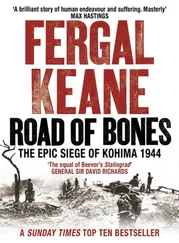1 ...8 9 10 12 13 14 ...30 By July the flood of refugees had diminished to a trickle, and once the influx had come to an end Kohima and the Naga Hills settled into a nervous peace. The Japanese 15th Army was sitting on the other side of the Chindwin river, about seventy miles away at the nearest point. But they had halted for now. The Indian official history recorded that, by June 1942, ‘the onset of monsoon, long lines of communication in the rear, the need for reorganising forces for a major venture and opposition [in India] to any external aggression, prevented the Japanese from extending their conquests beyond Burma.’ The physical barriers to an attack were considerable. Between Kohima and the Japanese lay the Chindwin river and a mountain range, whose 8,000 foot peaks and steep jungled valleys were thought to be impassable by large military formations. If there was to be an invasion of India, the British believed it would come further south, via the Imphal plain or through the Burmese province of Arakan into Bengal. For now, Charles Pawsey could concentrate on re-establishing the normal routines of colonial administration.
By the time he became deputy commissioner at Kohima, Charles Pawsey was thirty-five years old and he had already exceeded his own life expectancy by many years. He was one of those rare creatures who had enlisted in 1914 as a teenage officer and survived to see the armistice in 1918. Educated at Berkhamsted, where he was briefly a contemporary of Graham Greene, Pawsey was an enthusiastic cadet and was praised in the school magazine for his ‘doggedness’ on the athletics track. He went on to study classics at Oxford, but when the First World War broke out Pawsey joined the Territorial Army and was commissioned in time to join the 1/8 Worcestershire Regiment in France in April 1915. More than two decades later, at Kohima, in the midst of another terrible battle, Pawsey would remember the experience of clearing the dead from the trenches at Serre on the Somme. The rotting corpses lay everywhere and ‘those trenches remained long in the memories of the officers and men, as their worst experience of the horrors of the field of a great battle’. Pawsey distinguished himself by going out repeatedly into no-man’s-land in daylight to rescue wounded men, until he was caught in a German gas attack and invalided away from the front. He was awarded the Military Cross for his bravery on the Somme, before being transferred to the Italian front in 1917. There he was captured during hand-to-hand fighting on the Asiago plateau, some 4,000 feet up in the mountains above Lake Garda. Captain Pawsey was a prisoner of the Austro-Hungarian empire until the armistice in November. Then he and a few other British prisoners commandeered a train with a wood-burning engine and rode south to freedom.
Discharged from the army in 1919, he might have chosen to return to Oxford to continue his studies. But Charles Pawsey decided instead to go to India, where he had family connections. His uncle Roger had served as a government collector in east Bengal. He successfully sat the exams for the Indian Civil Service and was assigned to work as an assistant commissioner in the province of Assam in the north-east. It was a job that would involve extensive travel in remote districts, with considerable risk from malaria and the potential for encounters with hostile tribes. Yet to a young man who had survived the horrors of the First World War the journey to Assam must have held fantastic promise. With its vast tea estates, trackless jungles and tribes of headhunters, it was unimaginably far from the desolation of post-war Europe.
Pawsey rose steadily through the ranks of the Indian Civil Service, spending much of his time engaged in resolving land disputes, and eventually reaching the rank of deputy commissioner of the Naga Hills, in which role he acted as de facto ruler of more than 40,000 tribespeople in an area that covered 6,400 square miles of some of the most remote territory on the planet. On clear nights Charles Pawsey would stand on his veranda and look out over the valley to see shoals of stars splashed across the Naga Hills. To the east this silvered horizon dropped behind the mountains into Burma, and westwards it stretched towards the plains of Assam and the distant India of cities and crowds. Situated at 4,137 feet, and with no swampland nearby, Kohima was regarded as the healthiest settlement in the area. The air was clear and mountain streams provided a continuous supply of fresh water flowing into a tank in Pawsey’s garden. Although temperatures could soar to 90° Fahrenheit in the middle of July, the weather was cool for most of the year. Like the rest of the region, Kohima was washed by the annual monsoon, when annual rainfall of as much as one hundred inches could bring movement along the local tracks to a halt.
The settlement was spread out along a ridge made up of a series of hills. Charles Pawsey and the local police commander had their bungalows on Summerhouse Hill at the northern end of the ridge. On the adjacent hills stretching southwards were the stores, workshops, clinics, barracks and jail of the colonial administration. Beyond these were the heights of Aradura Spur, which in turn led on to the dark and jungled form of Mount Pulebadze, towering over Kohima at 7,500 feet above sea level. On the other side of the valley, across the road linking Kohima with Dimapur to the north and Imphal to the south, lay the so-called Naga Village, where the huts of the tribespeople had gradually agglomerated to form a settlement of several hundred dwellings.
European visitors to Kohima first noticed the clear mountain air and the profusion of flowers. There was a famed local orchid called Vanda coerulea , its colour a striking blend of turquoise and maroon stippled with tiny squares, as well as rhododendron trees which could grow to over a hundred feet. The young English traveller Ursula Graham Bower first saw Kohima while on a visit to India in the winter of 1937. Entering Mr Pawsey’s domain she was first struck by the tidy appearance of the place, with its red-roofed bungalows and official buildings stretched across the mountain ridges; gazing further afield, she saw on each ridge a ‘shaggy village, its thatched roofs smoke-stained and weathered’. She was only twenty-three when she stood on the ridge and looked out over the valleys, but she felt irrevocably changed by that moment and in her writing we find a young woman faced with something that challenged her capacity for awe: ‘One behind the other the hills stretched away as far as the eye could see, in an ocean of peaks, a wilderness of steep fields and untouched forest, of clefts and gulfs and razorbacks which merged at last into a grey infinity. That landscape drew me as I had never known anything do before, with a power transcending the body, a force not of this world at all.’
Charles Pawsey’s bungalow stood above the road linking Kohima with Imphal. It was built of wood with a red tin roof and a spacious veranda; it was pretty and spacious, surrounded by pale pink cannas and scarlet rhododendrons, but not lavish. When a small road had to be cut to the bungalow, Pawsey, following the service rules, paid for it himself. Above the bungalow, reached via a terraced hill, was a tennis court upon which Pawsey’s occasional visitors could enjoy an hour or two of civilised sport. His life there was comfortable but not luxurious, for he was a man of ascetic temperament, driven by his work and a conviction that the welfare of the Naga people was his life’s mission. That he was a paternalist is beyond doubt – those who knew him remembered how he spoke of the Naga as ‘my children’. But that is not to cast him as a cartoon figure, the dutiful imperialist shepherding the childlike natives. He was driven by a sense of imperial duty but also by a deep, empathetic humanity, a quality that the horror of his experiences in the First World War had only served to deepen. Sachu Angami, a Naga born and brought up in Kohima, remembered seeing Pawsey walk around his bungalow garden every morning. ‘He was always calm and he would smile when he saw us children. But we were too scared to talk to this white man, of course. This was a man who, when he spoke, the words turned into orders that would be carried out.’
Читать дальше












